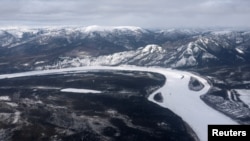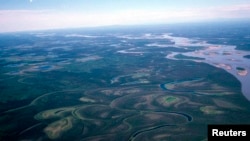Alaska’s Yukon River has faced major salmon shortages in recent years. The shortages are blamed on warming waters.
Officials say record-high temperatures last year killed most salmon in the 3,200-kilometer river before the fish were able to reproduce.
The losses led both Alaska and Canada to halt their salmon harvests in 2021 in order to make sure that enough fish survived to reproduce for another year. The situation caused local officials to send emergency fish shipments to communities along the river that depend on salmon for food.
Scientists have mostly blamed the problems on a series of heat waves in the Bering Sea and North Pacific Ocean from 2014 to 2019. The warm ocean waters affected salmon living in the sea before they returned to their spawning grounds.
The collapsed Yukon River salmon harvests caused major financial losses to private fishing companies in the area. The die-offs also hurt native communities, which traditionally store the fish as a year-round food supply.
In 2020, fishing companies on the Yukon River earned a combined $51,480. By comparison, they earned $2.5 million in 2019 and $4.67 million in 2018.
Last month, the U.S. Department of Commerce declared a disaster for Yukon River fishing for 2020 and 2021, making federal aid money available.
Alaska has sent emergency fish shipments to areas affected by the salmon shortages. The shipments came from more productive fisheries in the southwestern fishing community of Bristol Bay and other areas.
While the heat waves have passed, their effects have not, said fisheries scientist Katie Howard. She is with Alaska’s Department of Fish and Game. “We’re still seeing the residual effects,” Howard told a state legislative group earlier this month.
Climate change may also be affecting what the salmon are eating. Fishing experts say young salmon are likely filling up on nutrient-poor food like jellyfish because warmer waters drive away healthier organisms they normally feed on.
“In my opinion, the salmon are starving with climate change,” said Brooke Woods. She is with the Yukon River Inter-Tribal Fish Commission in the Athabascan village of Rampart.
The effects of climate change on freshwater environments have also been studied. Vanessa von Biela is a U.S. Geological Survey research biologist who looked at the rivers, streams and lakes where salmon spend early and late periods of the lives. Her team found that Chinook salmon show heat stress at temperatures above 18 degrees Celsius. They start dying above 20 Celsius.
In the past, Alaskan Yukon water temperatures stayed between 12 and 16 Celsius. But in 2019, temperatures on the Alaskan side were above 18 degrees Celsius for 44 straight days, a recent study found.
The effects of warming waters can be reduced by climate-driven glacier runoff, which brings cooler water into rivers and streams. But scientists still expect salmon to begin slowly moving to new areas within Alaska.
“Salmon will find a way,” said biologist von Biela. “But it is going to be hard for communities that are in places where there might not be salmon anymore."
I’m Bryan Lynn.
Reuters reported on this story. Bryan Lynn adapted the report for VOA Learning English.
We want to hear from you. Write to us in the Comments section, and visit our Facebook page.
________________________________________________________________
Words in This Story
spawn – v. when animals release or deposit eggs
residual – adj. remaining or left over
stream – n. a small river
stress – n. great worry or emotional difficulty
glacier – n. a large mass of ice that moves very slowly, usually down a hill or valley











